Adapting Fleming-Type Learning Style Classifications to Deaf Student Behavior
Abstract
:1. Introduction
2. Related Work
2.1. The Algorithm Used for Data Analysis
2.2. Analysis of Learning Factors
2.3. Learning Style
2.4. Learning for the Deaf
3. Methodology
3.1. Data Analysis Techniques
3.1.1. Decision Tree
- s refers to the number of data sets (e.g., s records);
- n refers to the total number of different groups in the data set;
- Ci refers to the group of order i where i = 1,…, n;
- si refers to the number of data points that belong to s in group Ci.
3.1.2. Random Forest
3.1.3. Bayesian Network
3.1.4. Naïve Bayes
- P(C) refers to the probability of the incident before incident C occurs;
- P(A) refers to the probability of the incident before data set A;
- P(C|A) refers to the probability of incident C when incident A occurs;
- P(A|C) refers to the probability of incident A when incident C occurs.
3.1.5. K-Nearest Neighbor
3.1.6. Multi-Layer Perceptron
3.2. Dividing Data to Test the Efficiency of the Classification Model
3.3. Information Gain
3.4. Synthetic Minority Oversampling Technique
- Npoint refers to a newly developed data point of the minority class;
- Opoint refers to a data point of the minority class as a starting point of the distance compared with the neighboring point;
- Random [0, 1] refers to a random number between 0 and 1;
- distance(x, y, …, z) refers to the distance between the starting point and the neighboring point from attributes x and y to z.
3.5. Index of Item–Objective Congruence
3.6. Research Methodology
3.6.1. Work Plan of the VRK + TSL Rule Model
- The related predictor of VRK + TSL learning (Figure 2).
- A questionnaire is developed to determine the predictor for the VRK + TSL learning style, which investigates the factors that affect learning among the deaf. A Likert scale is then used to evaluate the results [82].
- The questionnaires are analyzed by five experts.
- The expert comments are gathered and averaged scores greater than 3.50 are used to construct the appropriate learning pattern.
- 2.
- VRK + TSL learning pattern questionnaires for deaf students (Figure 3).
- 3.
- VRK + TSL learning styles analysis using data mining (Figure 5).
- The questionnaires were collected from the deaf students at the special schools in Khon Kaen and Udon Thani, Thailand, as shown in Table 1.
- The data were then screened and any non-useful content was discarded.
- The data were classified into four learning groups based on the VRK + TSL model and converted into the format necessary for the next processing step.
- Data analysis was conducted using data mining via the decision tree, random forest, Bayesian network, naïve Bayes, multi-layer perceptron, and KNN algorithms. Feature selection was utilized to help select the right feature in the analysis, and feature selection was used with SMOTE to solve data imbalance problems.
- After analysis, models were developed and assessed for optimum suitability and effectiveness.
3.6.2. Efficacy Measurement
4. Results
5. Discussion
6. Conclusions and Recommendations
6.1. Conclusions
6.2. Recommendations
- Further education should be based on the classification of learning styles for deaf students, focusing on areas where they have preferences, as being engaged and enjoying the educational process benefits future careers.
- Learning factors for deaf students could be further expanded, potentially leading to the discovery of other more important factors.
- The concept of the model used in this study could be applied to teaching, prediction, or instructional media for deaf students or other learners with special needs.
- The data analysis employed in this research was adapted specifically for deaf students and could be further applied to other groups with imbalanced data, for example, speech-impaired or visually impaired learners.
Author Contributions
Funding
Institutional Review Board Statement
Informed Consent Statement
Data Availability Statement
Acknowledgments
Conflicts of Interest
References
- Office of the National Education Commission; Office of the Prime Minister, Tailand. National Education Act of B.E. 2542; Cabinet and Royal Gazette Publishing Office: Bangkok, Thailand, 1999; p. 28. [Google Scholar]
- Jiawei Han, M.K. Data Mining: Concepts and Techniques, 2nd ed.; Morgan Kaufmann Publishers: Burlington, MA, USA, 2006. [Google Scholar]
- Baker, R.S.J.D.; Yacef, K. The State of Educational Data Mining in 2009: A Review and Future Visions. J. Educ. Data Min. 2009, 1, 3–17. [Google Scholar]
- Romero, C.; Ventura, S.; García, E. Data mining in course management systems: Moodle case study and tutorial. Comput. Educ. 2008, 51, 368–384. [Google Scholar] [CrossRef]
- Lee, Y.J. Developing an efficient computational method that estimates the ability of students in a Web-based learning environment. Comput. Educ. 2012, 58, 579–589. [Google Scholar] [CrossRef]
- Wang, M.; Jia, H.; Sugumaran, V.; Ran, W.; Liao, J. A web-based learning system for software test professionals. IEEE Trans. Educ. 2011, 54, 263–272. [Google Scholar] [CrossRef] [Green Version]
- Bhattacharyya, E.; Shariff, A.B.M.S. Learning Style and its Impact in Higher Education and Human Capital Needs. Procedia Soc. Behav. Sci. 2014, 123, 485–494. [Google Scholar] [CrossRef] [Green Version]
- Hundhausen, C.D.; Olivares, D.M.; Carter, A.S. IDE-based learning analytics for computing education: A process model, critical review, and research agenda. ACM Trans. Comput. Educ. 2017, 17, 1–26. [Google Scholar] [CrossRef]
- Pantho, O.; Tiantong, M. Using Decision Tree C4. 5 Algorithm to Predict VARK Learning Styles. Int. J. Comput. Internet Manag. 2016, 24, 58–63. [Google Scholar]
- Paireekreng, W.; Prexawanprasut, T. An integrated model for learning style classification in university students using data mining techniques. In Proceedings of the ECTI-CON 2015–2015 12th International Conference on Electrical Engineering/Electronics, Computer, Telecommunications and Information Technology, Hua Hin, Thailand, 24–27 June 2015; pp. 1–5. [Google Scholar]
- Chang, Y.C.; Kao, W.Y.; Chu, C.P.; Chiu, C.H. A learning style classification mechanism for e-learning. Comput. Educ. 2009, 53, 273–285. [Google Scholar] [CrossRef]
- Petchboonmee, P.; Phonak, D.; Tiantong, M. A Comparative Data Mining Technique for David Kolb’s Experiential Learning Style Classification. Int. J. Inf. Educ. Technol. 2015, 5, 672–675. [Google Scholar]
- Ahmad, N.B.H.; Shamsuddin, S.M.; Ahmad, N.B.H.; Shamsuddin, S.M. A comparative analysis of mining techniques for automatic detection of student’s learning style. In Proceedings of the 2010 10th International Conference on Intelligent Systems Design and Applications, ISDA’10, Cairo, Egypt, 29 November–1 December 2010; pp. 877–882. [Google Scholar]
- Deo, T.Y.; Patange, A.D.; Pardeshi, S.S.; Jegadeeshwaran, R.; Khairnar, A.N.; Khade, H.S. A White-Box SVM Framework and its Swarm-Based Optimization for Supervision of Toothed Milling Cutter through Characterization of Spindle Vibrations. arXiv 2021, arXiv:2112.08421. [Google Scholar]
- Patange, A.D.; Jegadeeshwaran, R. Application of bayesian family classifiers for cutting tool inserts health monitoring on CNC milling. Int. J. Progn. Heal. Manag. 2020, 11. [Google Scholar] [CrossRef]
- Patil, S.S.; Pardeshi, S.S.; Patange, A.D.; Jegadeeshwaran, R. Deep Learning Algorithms for Tool Condition Monitoring in Milling: A Review. In Proceedings of the International Virtual Conference on Intelligent Robotics, Mechatronics and Automation Systems 2021, Chennai, India, 26–27 March 2021; Volume 1969, p. 12039. [Google Scholar]
- Carter, A.S.; Hundhausen, C.D.; Adesope, O. Blending measures of programming and social behavior into predictive models of student achievement in early computing courses. ACM Trans. Comput. Educ. 2017, 17, 1–20. [Google Scholar] [CrossRef]
- Rakap, S. Impacts of learning styles and computer skills on adult students’ learning online. Turk. Online J. Educ. Technol. 2010, 9, 108–115. [Google Scholar]
- Hossain, M.M.; Abdullah, A.B.M.; Prybutok, V.R.; Talukder, M. the Impact of Learning Style on Web Shopper Electronic Catalog Feature Preference. J. Electron. Commer. Res. 2009, 10, 1–12. [Google Scholar]
- James, S.; D’Amore, A.; Thomas, T. Learning preferences of first year nursing and midwifery students: Utilising VARK. Nurse Educ. Today 2011, 31, 417–423. [Google Scholar] [CrossRef] [PubMed]
- Hung, Y.H.; Chang, R.I.; Lin, C.F. Hybrid learning style identification and developing adaptive problem-solving learning activities. Comput. Hum. Behav. 2016, 55, 552–561. [Google Scholar] [CrossRef]
- Koch, J.; Salamonson, Y.; Rolley, J.X.; Davidson, P.M. Learning preference as a predictor of academic performance in first year accelerated graduate entry nursing students: A prospective follow-up study. Nurse Educ. Today 2011, 31, 611–616. [Google Scholar] [CrossRef] [PubMed]
- Ictenbas, B.D.; Eryilmaz, H. Determining learning styles of engineering students to improve the design of a service course. Procedia Soc. Behav. Sci. 2011, 28, 342–346. [Google Scholar] [CrossRef] [Green Version]
- Alkhasawneh, I.M.; Mrayyan, M.T.; Docherty, C.; Alashram, S.; Yousef, H.Y. Problem-based learning (PBL): Assessing students’ learning preferences using vark. Nurse Educ. Today 2008, 28, 572–579. [Google Scholar] [CrossRef] [PubMed]
- Jena, R.K. Predicting students’ learning style using learning analytics: A case study of business management students from India. Behav. Inf. Technol. 2018, 37, 978–992. [Google Scholar] [CrossRef]
- Felder, R.; Silverman, L. Learning and Teaching Styles in Engineering Education. Eng. Educ. 1988, 78, 674–681. [Google Scholar]
- Kolb, D.A. Experiential Learning: Experience as The Source of Learning and Development. Prentice Hall Inc. 1984, 1, 20–38. [Google Scholar]
- Kolb, D.A. Disciplinary inquiry norms and student learning styles: Diverse pathways for growth. Mod. Am. Coll. 1981, 21–43. Available online: https://www.researchgate.net/publication/283922529_Learning_Styles_and_Disciplinary_Differences (accessed on 15 March 2022).
- Felder, R.M. Reaching the second tier. Journal of College Science Teaching. J. Coll. Sci. Teach. 1993, 23, 286–290. [Google Scholar]
- Fleming, N.D. Teaching and Learning Styles: VARK Strategies; IGI Global: Christchurch, New Zealand, 2001; ISBN 0473079569. [Google Scholar]
- Eicher, J.P. Making the Message Clear: Communicating for Business; Grinder Delozier & Assoc: Scotts Valley, CA, USA, 1987; ISBN 0929514009. [Google Scholar]
- Hawk, T.F.; Shah, A.J. Using Learning Style Instruments to Enhance Student Learning. Decis. Sci. J. Innov. Educ. 2007, 5, 1–19. [Google Scholar] [CrossRef]
- Fleming, N.D. I’m different; not dumb. Modes of presentation (VARK) in the tertiary classroom. In Proceedings of the Research and Development in Higher Education, Proceedings of the Annual Conference of the Higher Education and Research Development Society of Australasia, Rockhampton, QLD, Australia, 4–7 July 1995; 1995; Volume 18, pp. 308–313. [Google Scholar]
- Fleming, N.; Baume, D. Learning Styles Again: Varking Up the Right Tree! Educational Developments; SEDA Ltd: Blackwood, UK, 2006; Volume 7, pp. 4–7. [Google Scholar]
- Al-Jumeily, D.; Hussain, A.; Alghamdi, M.; Dobbins, C.; Lunn, J. Educational crowdsourcing to support the learning of computer programming. Res. Pract. Technol. Enhanc. Learn. 2015, 10, 13. [Google Scholar] [CrossRef] [Green Version]
- AlKhasawneh, E. Using VARK to assess changes in learning preferences of nursing students at a public university in Jordan: Implications for teaching. Nurse Educ. Today 2013, 33, 1546–1549. [Google Scholar] [CrossRef]
- Liew, S.C.; Sidhu, J.; Barua, A. The relationship between learning preferences (styles and approaches) and learning outcomes among pre-clinical undergraduate medical students Approaches to teaching and learning. BMC Med. Educ. 2015, 15, 44. [Google Scholar] [CrossRef] [Green Version]
- Drago, W.A.; Wagner, R.J. Vark preferred learning styles and online education. Manag. Res. News 2004, 27, 1–13. [Google Scholar] [CrossRef]
- Dutsinma, L.I.F.; Temdee, P. VARK Learning Style Classification Using Decision Tree with Physiological Signals. Wirel. Pers. Commun. 2020, 115, 2875–2896. [Google Scholar] [CrossRef]
- Truong, H.M. Integrating learning styles and adaptive e-learning system: Current developments, problems and opportunities. Comput. Hum. Behav. 2016, 55, 1185–1193. [Google Scholar] [CrossRef]
- Jones, M.; Oviatt, S.; Brewster, S.; Penn, G.; Munteanu, C.; Whittaker, S.; Rajput, N.; Nanavati, A. We Need to Talk: HCI and the Delicate Topic of Spoken Language Interaction. In Proceedings of the Conference on Human Factors in Computing Systems—Proceedings, Paris, France, 27 April–2 May 2013; Volume 2013, pp. 2459–2464. [Google Scholar]
- Matthews, T.; Carter, S.; Pai, C.; Fong, J.; Mankoff, J. Scribe4Me: Evaluating a Mobile Sound Transcription Tool for the Deaf. In Lecture Notes in Computer Science (Including Subseries Lecture Notes in Artificial Intelligence and Lecture Notes in Bioinformatics), Proceedings of the International Conference on Ubiquitous Computing, Orange County, CA, USA, 17–21 September 2006; Springer: Amsterdam, The Netherlands, 2006; Volume 4206 LNCS, pp. 159–176. [Google Scholar]
- Kafle, S.; Huenerfauth, M. Predicting the understandability of imperfect english captions for people who are deaf or hard of hearing. ACM Trans. Access. Comput. 2019, 12, 1–32. [Google Scholar] [CrossRef]
- Nanayakkara, S.C.; Wyse, L.; Ong, S.H.; Taylor, E.A. Enhancing musical experience for the hearing-impaired using visual and haptic displays. Hum. Comput. Interact. 2013, 28, 115–160. [Google Scholar]
- Jacobs, L.M. A Deaf Adult Speaks Out; Gallaudet University Press: Chicago, IL, USA, 1974. [Google Scholar]
- Stokoe, W.C.; Marschark, M. Sign language structure: An outline of the visual communication systems of the american deaf. J. Deaf. Stud. Deaf. Educ. 2005, 10, 3–37. [Google Scholar] [CrossRef] [Green Version]
- Liddell, S.K. American Sign Language; Mouton De Gruyter: Berlin, Germany, 1980. [Google Scholar]
- De Guilhermino Trindade, D.F.; Guimares, C.; Antunes, D.R.; Sánchez Garcia, L.; da Lopes, S.R.A.; Fernandes, S. Challenges of knowledge management and creation in communities of practice organisations of Deaf and non-Deaf members: Requirements for a Web platform. Behav. Inf. Technol. 2012, 31, 799–810. [Google Scholar] [CrossRef]
- LeMaster, B.; Monaghan, L. Variation in Sign languages. In A companion to Linguist; Alessandro Duranti, Blackwell: Carlton, Australia, 2004; pp. 141–165. [Google Scholar]
- Zeshan, U. Sign Languages of the World. In Encyclopedia of Language & Linguistics; Brown, K., Ed.; Elsevier: Oxford, UK, 2006; pp. 358–365. [Google Scholar]
- Nonaka, A.M. (Almost) everyone here spoke Ban Khor Sign Language—Until they started using TSL: Language shift and endangerment of a Thai village sign language. Lang. Commun. 2014, 38, 54–72. [Google Scholar] [CrossRef]
- Zhao, Y.; Sun, P.; Xie, R.; Chen, H.; Feng, J.; Wu, X. The relative contributions of phonological awareness and vocabulary knowledge to deaf and hearing children’s reading fluency in Chinese. Res. Dev. Disabil. 2019, 92, 103444. [Google Scholar] [CrossRef]
- Webster, A. Deafness, Development and Literacy; Methuen & Co. Ltd: London, UK, 2017; ISBN 9781351236010. [Google Scholar]
- Myklebust, H.R. The Psychology of Deafness: Sensory Deprivation, Learning, and Adjustment; Grune and Stratton: New York, NY, USA, 1964; Volume 2. [Google Scholar]
- Berry, M.J.A.; Linoff, G.S. Data Mining Techniques: For Marketing, Sales, and Customer Relationship Management; John Wiley & Sons: Hoboken, NJ, USA, 2004; ISBN 0471179809. [Google Scholar]
- Han, J.; Kamber, M.; Pei, J. Data Mining: Concepts and Techniques: Concepts and Techniques, 3rd ed.; Elsevier: Amsterdam, The Netherlands, 2012; ISBN 978-0-12-381479-1. [Google Scholar]
- Sharma, T.C.; Jain, M. WEKA Approach for Comparative Study of Classification Algorithm. Int. J. Adv. Res. Comput. Commun. Eng. 2013, 2, 1925–1931. [Google Scholar]
- Lin, C.F.; Yeh, Y.C.; Hung, Y.H.; Chang, R.I. Data mining for providing a personalized learning path in creativity: An application of decision trees. Comput. Educ. 2013, 68, 199–210. [Google Scholar] [CrossRef]
- Wu, X.; Kumar, V.; Ross, Q.J.; Ghosh, J.; Yang, Q.; Motoda, H.; McLachlan, G.J.; Ng, A.; Liu, B.; Yu, P.S.; et al. Top 10 algorithms in data mining. Knowl. Inf. Syst. 2008, 14, 1–37. [Google Scholar] [CrossRef] [Green Version]
- Amatriain, X.; Pujol, J.M. Data mining methods for recommender systems. In Recommender Systems Handbook, 2nd ed.; Springer: Berlin/Heidelberg, Germany, 2015; pp. 227–262. ISBN 9781489976376. [Google Scholar]
- Yin, H.H.S.; Langenheldt, K.; Harlev, M.; Mukkamala, R.R.; Vatrapu, R. Regulating Cryptocurrencies: A Supervised Machine Learning Approach to De-Anonymizing the Bitcoin Blockchain. J. Manag. Inf. Syst. 2019, 36, 37–73. [Google Scholar] [CrossRef]
- Breiman, L. Random Forests. Mach. Learn. 2001, 45, 5–32. [Google Scholar] [CrossRef] [Green Version]
- Wang, Z.; Jiang, C.; Zhao, H.; Ding, Y. Mining semantic soft factors for credit risk evaluation in Peer-to-Peer lending. J. Manag. Inf. Syst. 2020, 37, 282–308. [Google Scholar] [CrossRef]
- Grushka-Cockayne, Y.; Jose, V.R.R.; Lichtendahl, K.C. Ensembles of overfit and overconfident forecasts. Manag. Sci. 2017, 63, 1110–1130. [Google Scholar] [CrossRef]
- Liaw, A.; Wiener, M. Classification and Regression by randomForest. R News 2002, 2, 18–22. [Google Scholar]
- Friedman, N.; Geiger, D.; Goldszmidt, M. Bayesian Network Classifiers. Mach. Learn. 1997, 29, 131–163. [Google Scholar] [CrossRef] [Green Version]
- Ko, Y. How to use negative class information for Naive Bayes classification. Inf. Process. Manag. 2017, 53, 1255–1268. [Google Scholar] [CrossRef]
- Lee, C.H. An information-theoretic filter approach for value weighted classification learning in naive Bayes. Data Knowl. Eng. 2018, 113, 116–128. [Google Scholar] [CrossRef]
- Cover, T.M.; Hart, P.E. Nearest Neighbor Pattern Classification. IEEE Trans. Inf. Theory 1967, 13, 21–27. [Google Scholar] [CrossRef]
- Zhang, M.-L.; Zhou, Z.-H. A k-nearest neighbor based algorithm for multi-label classification. In Proceedings of the 2005 IEEE International Conference on Granular Computing IEEE, Beijing, Chaina, 25–27 July 2005; Volume 2, pp. 718–721. [Google Scholar]
- McCulloch, W.S.; Pitts, W.H. A logical calculus of the ideas immanent in nervous activity. In Systems Research for Behavioral Science: A Sourcebook; Springer: Berlin/Heidelberg, Germany, 2017; Volume 5, pp. 93–96. ISBN 9781351487214. [Google Scholar]
- Mosier, C.I.I. Problems and Designs of Cross-Validation 1. Educ. Psychol. Meas. 1951, 11, 5–11. [Google Scholar] [CrossRef]
- Stone, M. Cross-Validatory Choice and Assessment of Statistical Predictions (With Discussion). J. R. Stat. Soc. Ser. B 1974, 36, 111–133. [Google Scholar] [CrossRef]
- Tibshirani, R.J.; Tibshirani, R. A bias correction for the minimum error rate in cross-validation. Ann. Appl. Stat. 2009, 3, 822–829. [Google Scholar] [CrossRef] [Green Version]
- Chen, K.; Lei, J. Network Cross-Validation for Determining the Number of Communities in Network Data. J. Am. Stat. Assoc. 2018, 113, 241–251. [Google Scholar] [CrossRef] [Green Version]
- Liu, Y.; Liao, S. Granularity selection for cross-validation of SVM. Inf. Sci. 2017, 378, 475–483. [Google Scholar] [CrossRef]
- Yan, L.; He, Y.; Qin, L.; Wu, C.; Zhu, D.; Ran, B. A novel feature extraction model for traffic injury severity and its application to Fatality Analysis Reporting System data analysis. Sci. Prog. 2020, 103, 0036850419886471. [Google Scholar] [CrossRef]
- Pal, N.R.; Pal, S.K. Entropy: A New Definition and its Applications. IEEE Trans. Syst. Man Cybern. 1991, 21, 1260–1270. [Google Scholar] [CrossRef] [Green Version]
- Chawla, N.V.; Bowyer, K.W.; Hall, L.O.; Kegelmeyer, W.P. SMOTE: Synthetic minority over-sampling technique. J. Artif. Intell. Res. 2002, 16, 321–357. [Google Scholar] [CrossRef]
- Rovinelli, R.J.; Hambleton, R.K. On the Use of Content Specialists in the Assessment of Criterion-Referenced Test Item Validity. Dutch J. Educ. Res. 1977, 2, 49–60. [Google Scholar]
- Krishnamoorthy, D.; Lokesh, D. Process of building a dataset and classification of vark learning styles with machine learning and predictive analytics models. J. Contemp. Issues Bus. Gov. 2021, 26, 903–910. [Google Scholar]
- Likert, R. A technique for the measurement of attitudes. Arch. Psychol. 1932, 22, 55. [Google Scholar]
- Ali, H.; Salleh, M.N.M.; Saedudin, R.; Hussain, K.; Mushtaq, M.F. Imbalance class problems in data mining: A review. Indones. J. Electr. Eng. Comput. Sci. 2019, 14, 1560–1571. [Google Scholar] [CrossRef]
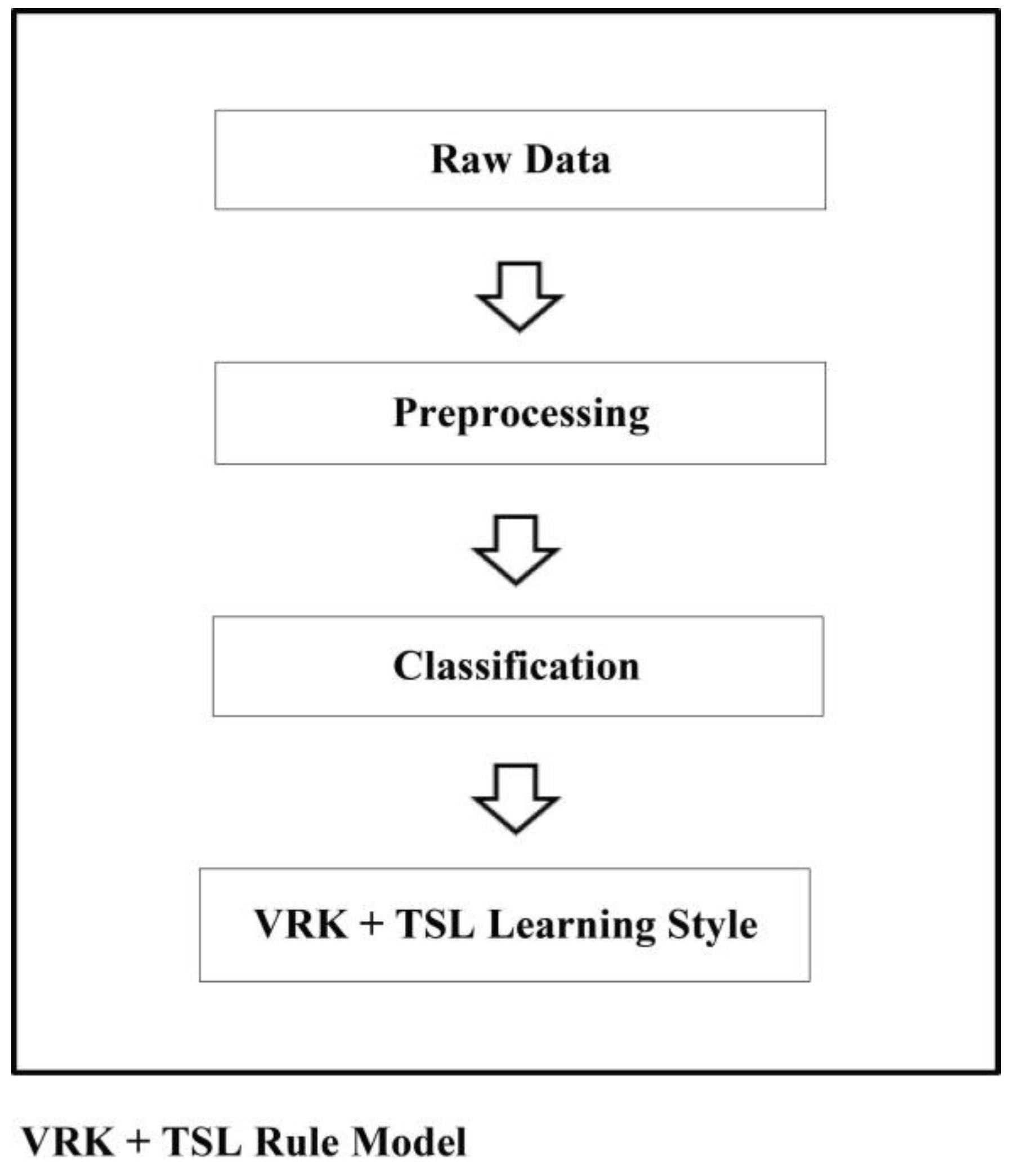

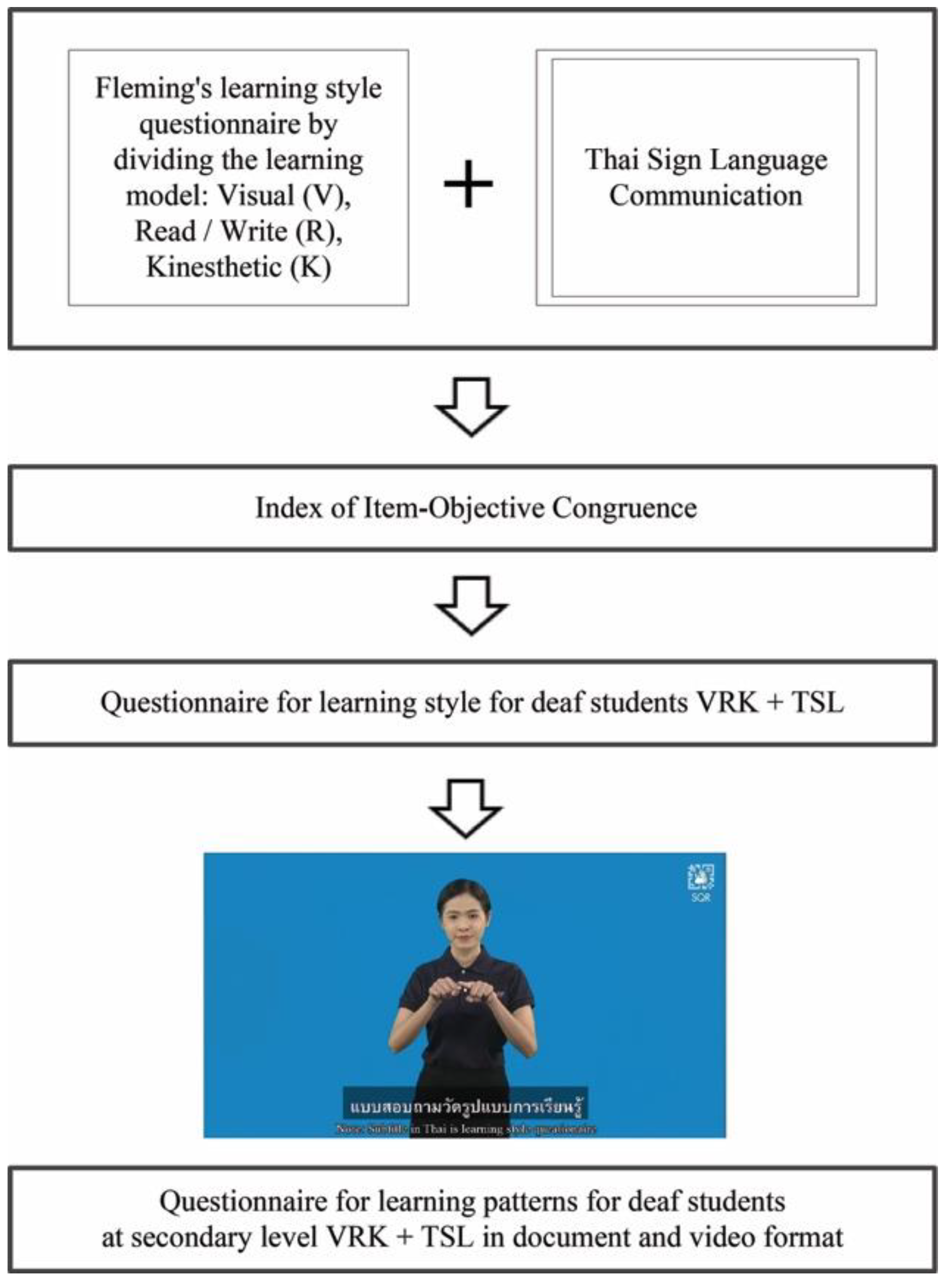
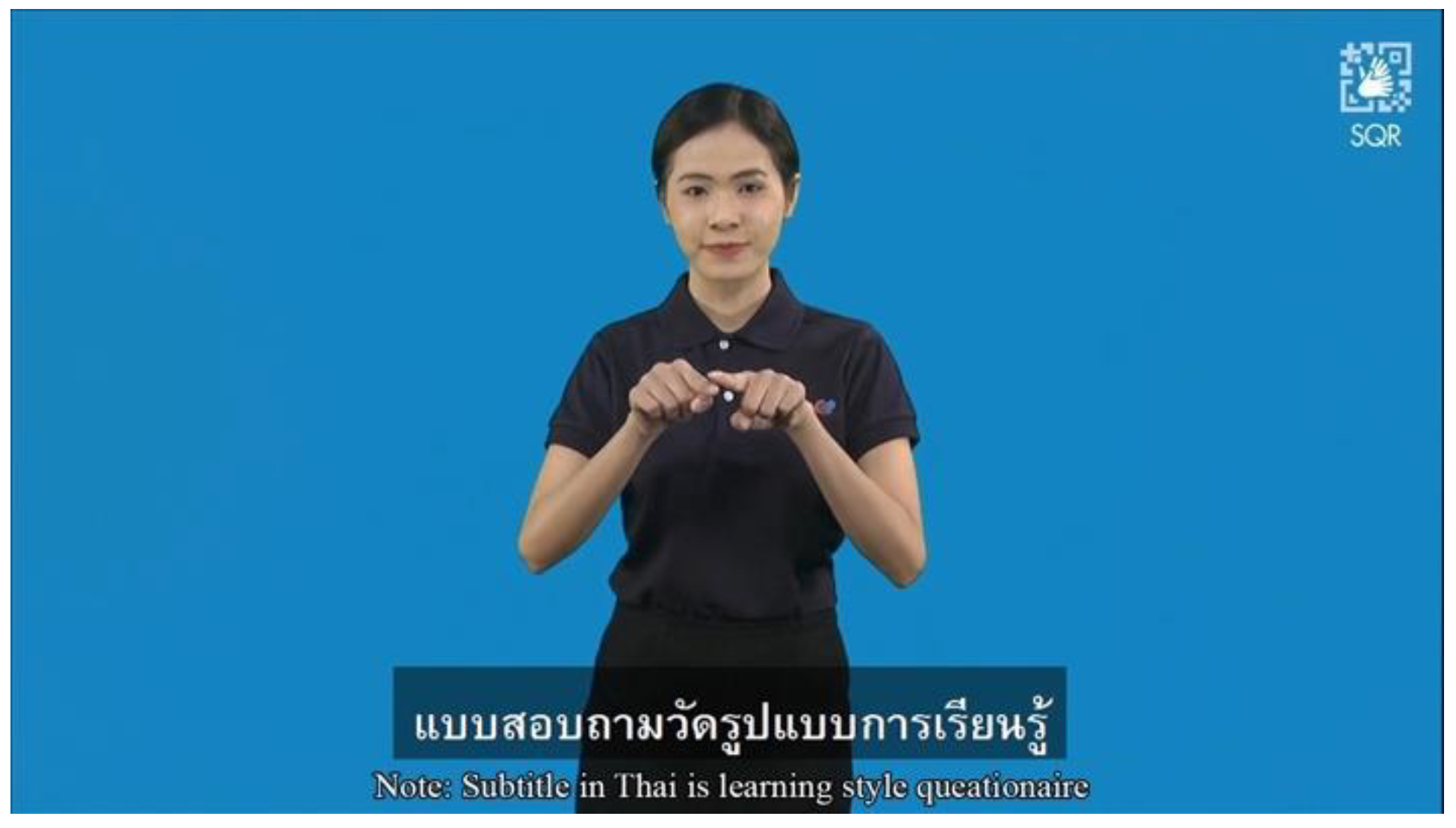
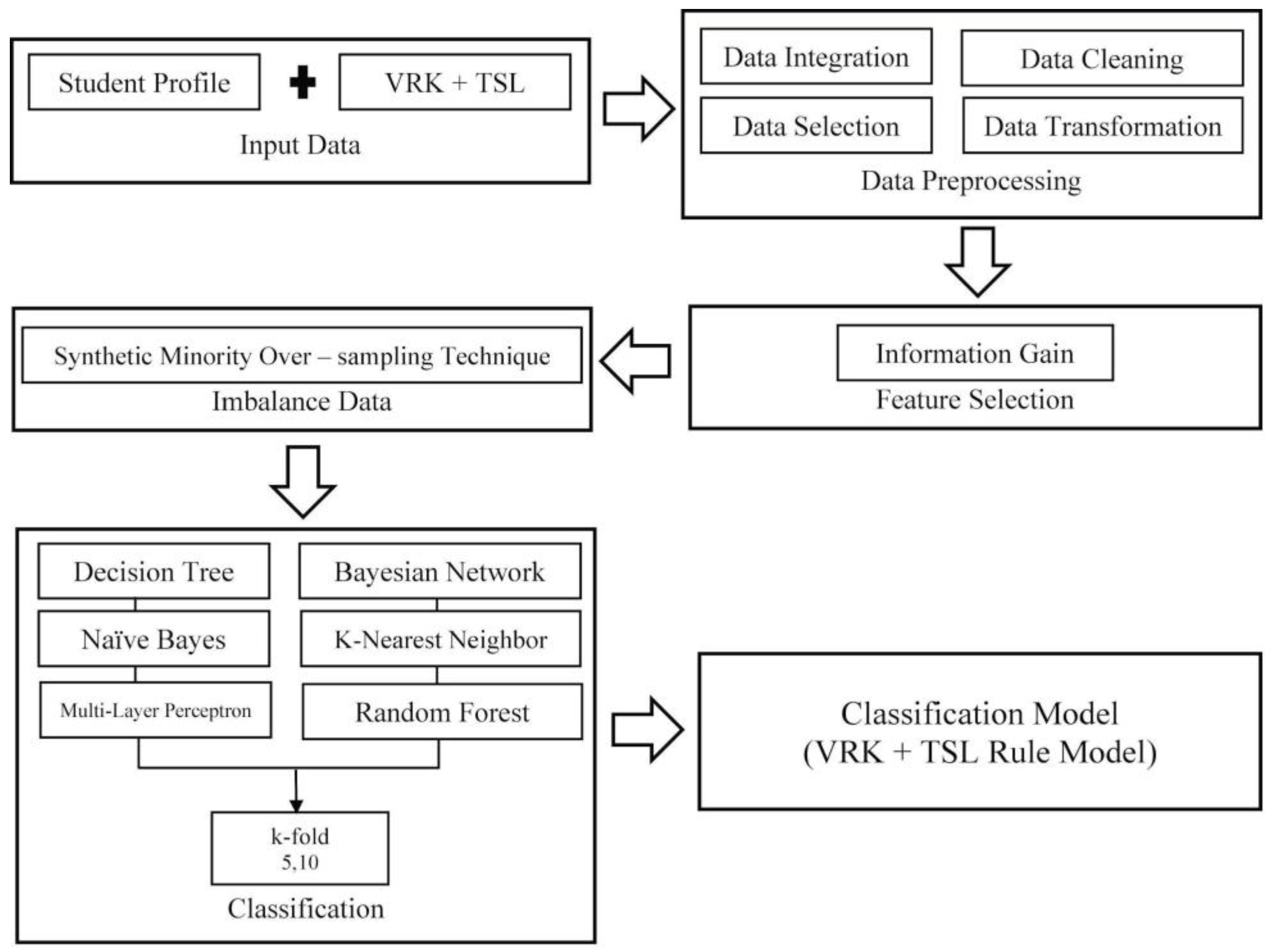
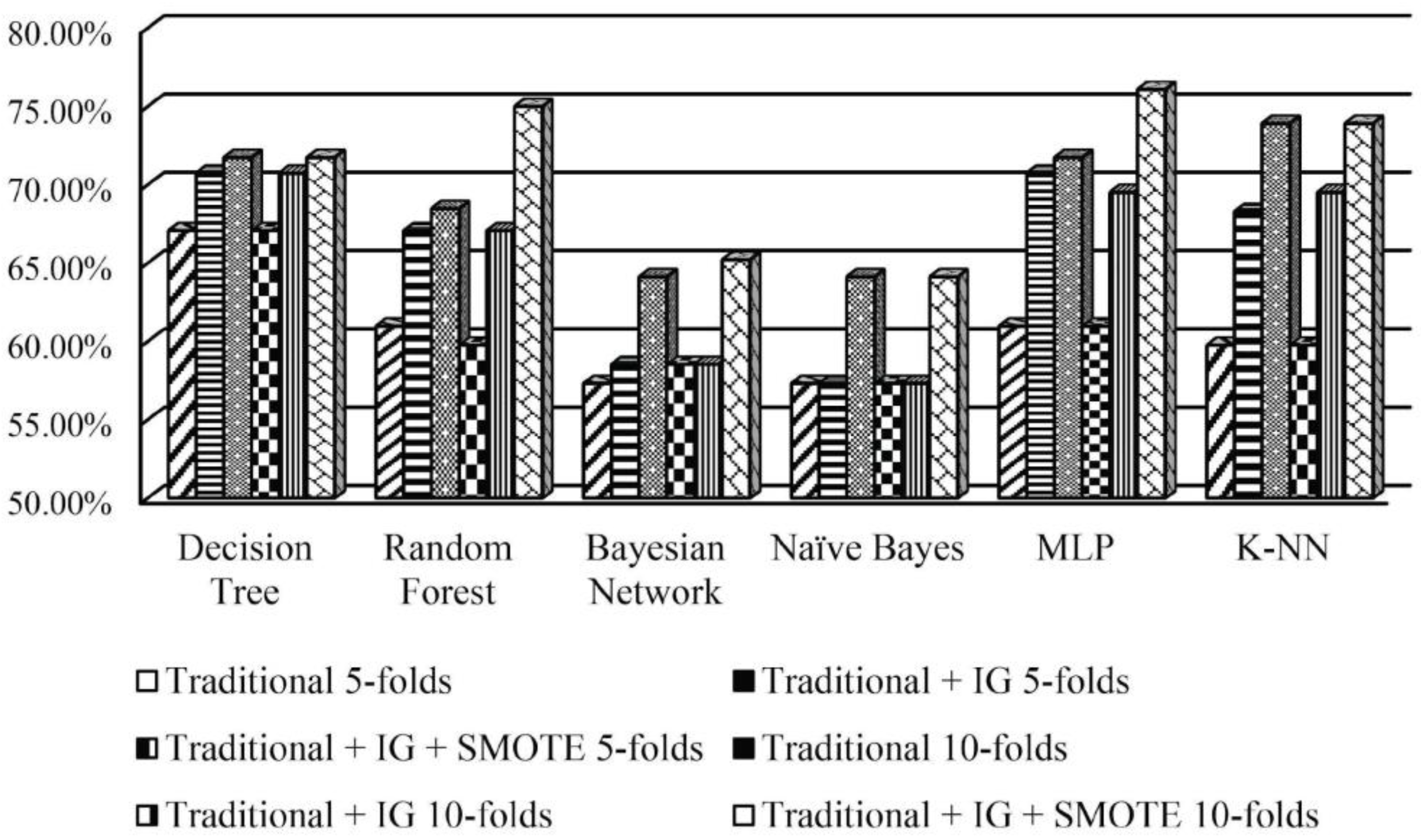
| Gender | Age | Level | Grade | Habitat | School before Entering | Domicile | School for the Deaf | Learning Style |
|---|---|---|---|---|---|---|---|---|
| Female | 13 | G.7 | 3.90 | Dorm | School of the Deaf | Kalasin | Khon Kaen | V |
| Male | 14 | G.8 | 3.25 | Dorm | School of the Deaf | Khon Kaen | Khon Kaen | K |
| Male | 14 | G.8 | 3.46 | Dorm | School of the Deaf | Sakon Nakhon | Udon Thani | TSL |
| Female | 16 | G.9 | 3.00 | Dorm | School of the Deaf | Udon Thani | Udon Thani | K |
| Data Division | Algorithm | TP Rate | FP Rate | Precision | Recall | F-Measure | Accuracy |
|---|---|---|---|---|---|---|---|
| 5-fold | Decision Tree | 0.671 | 0.237 | 0.644 | 0.671 | 0.637 | 67.0732% |
| Decision Tree + IG | 0.707 | 0.205 | 0.693 | 0.707 | 0.682 | 70.7317% | |
| Decision Tree + IG + SMOTE | 0.717 | 0.168 | 0.723 | 0.717 | 0.703 | 71.7391% | |
| 10-fold | Decision Tree | 0.671 | 0.237 | 0.644 | 0.671 | 0.637 | 67.0732% |
| Decision Tree + IG | 0.707 | 0.205 | 0.693 | 0.707 | 0.682 | 70.7317% | |
| Decision Tree + IG + SMOTE | 0.717 | 0.168 | 0.723 | 0.717 | 0.703 | 71.7391% | |
| 5-fold | Random Forest | 0.573 | 0.252 | 0.553 | 0.573 | 0.561 | 57.3171% |
| Random Forest + IG | 0.671 | 0.222 | 0.671 | 0.671 | 0.650 | 67.0732% | |
| Random Forest + IG + SMOTE | 0.685 | 0.151 | 0.684 | 0.685 | 0.682 | 68.4783% | |
| 10-fold | Random Forest | 0.598 | 0.249 | 0.546 | 0.598 | 0.569 | 59.7561% |
| Random Forest + IG | 0.671 | 0.223 | 0.630 | 0.671 | 0.639 | 67.0732% | |
| Random Forest + IG + SMOTE | 0.750 | 0.145 | 0.739 | 0.750 | 0.737 | 75.0000% | |
| 5-fold | Bayesian Network | 0.573 | 0.405 | 0.453 | 0.573 | 0.497 | 57.3171% |
| Bayesian Network + IG | 0.585 | 0.402 | 0.479 | 0.585 | 0.515 | 58.5366% | |
| Bayesian Network + IG + SMOTE | 0.641 | 0.249 | 0.551 | 0.641 | 0.585 | 64.1304% | |
| 10-fold | Bayesian Network | 0.585 | 0.390 | 0.475 | 0.585 | 0.515 | 58.5366% |
| Bayesian Network + IG | 0.585 | 0.427 | 0.492 | 0.585 | 0.512 | 58.5366% | |
| Bayesian Network + IG + SMOTE | 0.652 | 0.264 | 0.567 | 0.652 | 0.590 | 65.2174% | |
| 5-fold | Naïve Bay | 0.573 | 0.405 | 0.453 | 0.573 | 0.497 | 57.3171% |
| Naïve Bay + IG | 0.573 | 0.417 | 0.457 | 0.573 | 0.497 | 57.3171% | |
| Naïve Bay + IG + SMOTE | 0.641 | 0.250 | 0.555 | 0.641 | 0.584 | 64.1304% | |
| 10-fold | Naïve Bay | 0.573 | 0.417 | 0.467 | 0.573 | 0.501 | 57.3171% |
| Naïve Bay + IG | 0.573 | 0.430 | 0.474 | 0.573 | 0.502 | 57.3171% | |
| Naïve Bay + IG + SMOTE | 0.641 | 0.259 | 0.550 | 0.641 | 0.581 | 64.1304% | |
| 5-fold | MLP | 0.610 | 0.271 | 0.574 | 0.610 | 0.582 | 60.9756% |
| MLP + IG | 0.707 | 0.229 | 0.694 | 0.707 | 0.676 | 70.7317% | |
| MLP + IG + SMOTE | 0.717 | 0.149 | 0.704 | 0.717 | 0.708 | 71.7391% | |
| 10-fold | MLP | 0.610 | 0.246 | 0.573 | 0.610 | 0.586 | 60.9756% |
| MLP + IG | 0.695 | 0.231 | 0.649 | 0.695 | 0.659 | 69.5122% | |
| MLP + IG + SMOTE | 0.761 | 0.141 | 0.752 | 0.761 | 0.745 | 76.0870% | |
| 5-fold | K − NN | 0.598 | 0.311 | 0.553 | 0.598 | 0.562 | 59.7561% |
| K − NN +IG | 0.683 | 0.232 | 0.679 | 0.683 | 0.658 | 68.2927% | |
| K − NN + IG + SMOTE | 0.739 | 0.149 | 0.745 | 0.739 | 0.722 | 73.9130% | |
| 10-fold | K − NN | 0.598 | 0.311 | 0.553 | 0.598 | 0.562 | 59.7561% |
| K − NN + IG | 0.695 | 0.229 | 0.692 | 0.695 | 0.668 | 69.5122% | |
| K − NN + IG + SMOTE | 0.739 | 0.149 | 0.745 | 0.739 | 0.722 | 73.9130% |
Publisher’s Note: MDPI stays neutral with regard to jurisdictional claims in published maps and institutional affiliations. |
© 2022 by the authors. Licensee MDPI, Basel, Switzerland. This article is an open access article distributed under the terms and conditions of the Creative Commons Attribution (CC BY) license (https://creativecommons.org/licenses/by/4.0/).
Share and Cite
Luangrungruang, T.; Kokaew, U. Adapting Fleming-Type Learning Style Classifications to Deaf Student Behavior. Sustainability 2022, 14, 4799. https://doi.org/10.3390/su14084799
Luangrungruang T, Kokaew U. Adapting Fleming-Type Learning Style Classifications to Deaf Student Behavior. Sustainability. 2022; 14(8):4799. https://doi.org/10.3390/su14084799
Chicago/Turabian StyleLuangrungruang, Tidarat, and Urachart Kokaew. 2022. "Adapting Fleming-Type Learning Style Classifications to Deaf Student Behavior" Sustainability 14, no. 8: 4799. https://doi.org/10.3390/su14084799
APA StyleLuangrungruang, T., & Kokaew, U. (2022). Adapting Fleming-Type Learning Style Classifications to Deaf Student Behavior. Sustainability, 14(8), 4799. https://doi.org/10.3390/su14084799







